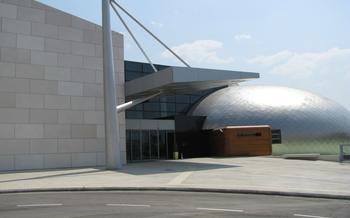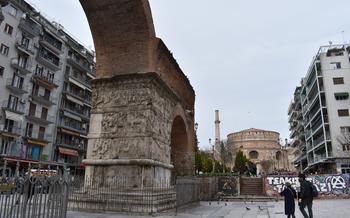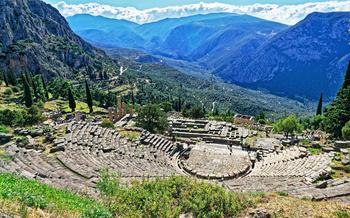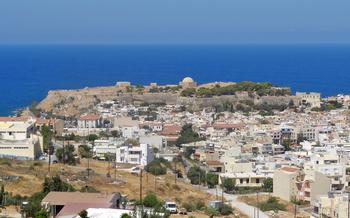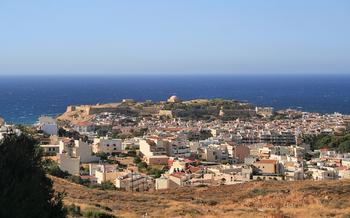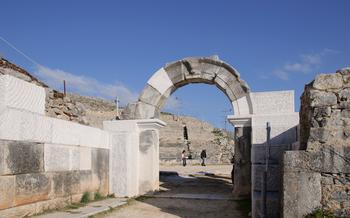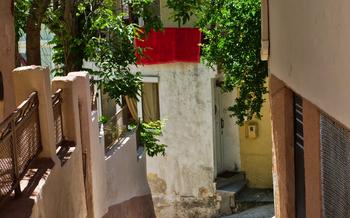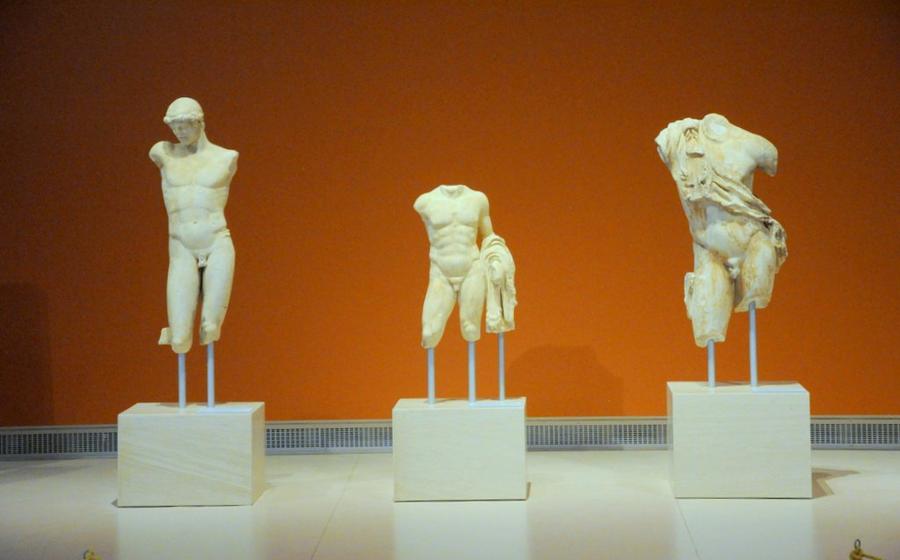
The Roman Villa of Patras
- The Antiquity of Patras
- Discovery of the Roman Villa
- Historical Significance of the Villa
- Architectural Marvels
- Residential Quarters
- Kitchen and Dining
- Entertainment and Leisure
- Water Supply and Sanitation
- Religious and Spiritual Practices
- Economic Activities
- Decline and Abandonment
- Restoration and Preservation
- Insider Tip
The Antiquity of Patras
Patras, a vibrant city in western Greece, boasts a rich and storied past dating back to ancient times. In the 3rd century BC, it emerged as a significant city-state, playing a pivotal role in the Achaean League, a powerful alliance of Greek city-states. Patras's strategic location on the Gulf of Patras made it a crucial port city, facilitating trade and cultural exchange throughout the Mediterranean.
In 146 BC, Greece fell under Roman rule, marking a new chapter in Patras's history. The city embraced Roman culture and administration, becoming an integral part of the vast Roman Empire. Under Roman rule, Patras flourished, experiencing economic growth and urban development. The Romans constructed impressive public buildings, temples, and theaters, transforming Patras into a thriving metropolis.
Archaeological excavations conducted in and around Patras have unearthed a wealth of artifacts, shedding light on the city's Roman past. Discoveries include intricate mosaics, elegant sculptures, and well-preserved architectural remains, providing valuable insights into the daily lives, customs, and traditions of the Roman inhabitants of Patras.
Discovery of the Roman Villa
The uncovering of the Roman Villa of Patras was a serendipitous event that occurred during construction work in the city in 188As workers dug the foundation for a new building, they stumbled upon intricate mosaic floors and well-preserved walls, hinting at the presence of an ancient structure. Recognizing the significance of the find, local authorities halted construction and called in archaeologists to investigate further.
Under the careful supervision of skilled archaeologists, the excavation process began, revealing the extent and grandeur of the villa. Layer by layer, the remains of rooms, courtyards, and intricate architectural features emerged, providing valuable insights into the luxurious lifestyle of Patras's Roman elite.
However, the excavation process was not without challenges. The site's proximity to modern buildings and the need to preserve the delicate remains required meticulous planning and careful execution. Archaeologists worked diligently to document and record every aspect of the villa, ensuring that its history and significance were preserved for future generations.
Historical Significance of the Villa
The Roman Villa of Patras holds immense historical significance, shedding light on the lavish lifestyle and customs of the Roman elite during the city's Roman period. Excavations have revealed that the villa was likely owned by wealthy and influential Roman families who played a prominent role in Patras's society and economy. The villa's grandeur and opulence reflect their privileged status and the extent of Roman influence in the region.
The discovery of the villa has provided valuable insights into the daily lives of the Roman elite. Archaeologists have unearthed personal artifacts such as jewelry, coins, and pottery, which offer glimpses into their personal tastes and habits. The well-preserved frescoes and mosaics depict scenes from mythology and everyday life, providing a visual narrative of the villa's inhabitants and their world.
The villa's significance extends beyond its individual history. It serves as a microcosm of Patras's role in the Roman Empire. As a major port city, Patras was a hub of trade and commerce, and the villa's opulence reflects the city's prosperity during this period. The villa's connection to wealthy Roman families highlights the city's importance as a center of power and influence within the empire.
Architectural Marvels
The Roman Villa of Patras boasts several architectural marvels that showcase the grandeur and artistry of the Roman Empire. The grand entrance, adorned with intricate carvings and flanked by towering columns, leads visitors into an impressive peristyle courtyard. This central courtyard, surrounded by a colonnade, provides a glimpse into the villa's spacious layout and elegant design.
The villa's floors are adorned with stunning mosaics, each tile meticulously arranged to depict mythological scenes, geometric patterns, and vibrant floral motifs. These mosaics not only enhance the visual appeal of the villa but also offer valuable insights into the artistic preferences and cultural influences of the Roman elite.
The walls of the villa are adorned with well-preserved frescoes and wall paintings, showcasing the remarkable skill of Roman artisans. These colorful murals depict scenes from Roman mythology, landscapes, and portraits, offering a glimpse into the artistic sensibilities and storytelling traditions of the period.
Residential Quarters
The Roman Villa of Patras boasts impressive residential quarters, reflecting the luxurious lifestyle of its wealthy occupants. The villa's spacious living areas include bedrooms, dining rooms, and reception halls, adorned with intricate mosaics, frescoes, and wall paintings that showcase the artistic prowess of Roman artisans.
The bedrooms, designed for comfort and privacy, feature elegant mosaic floors depicting mythological scenes or geometric patterns. The dining rooms, lavishly decorated with frescoes, served as grand settings for opulent banquets and social gatherings. Reception halls, the centerpieces of the villa, exuded grandeur and opulence, adorned with marble columns, intricate wall paintings, and delicate stuccowork.
Beyond the main living areas, the villa also offered its inhabitants modern conveniences and amenities. Underfloor heating systems ensured warmth and comfort during the colder months, while private baths, equipped with hot, cold, and tepid water, provided a luxurious bathing experience. The discovery of personal artifacts, such as jewelry, cosmetics, and pottery, offers a glimpse into the daily lives and personal grooming habits of the villa's occupants.
The residential quarters of the Roman Villa of Patras stand as a testament to the refined tastes and luxurious lifestyle of the Roman elite. These well-preserved spaces provide valuable insights into the domestic life and social customs of a bygone era, inviting visitors to step back in time and experience the grandeur of Roman living.
Kitchen and Dining
The Roman Villa of Patras boasts an impressive kitchen area that provides valuable insights into the culinary practices and dining habits of its wealthy inhabitants. The well-equipped kitchen features ovens, hearths, and ample storage spaces, indicating the importance of food preparation and dining in Roman culture.
Excavations have unearthed a variety of cooking utensils and tableware, including pots, pans, plates, and cups, showcasing the sophisticated culinary techniques employed in the villa. These artifacts suggest that the villa's occupants enjoyed a diverse and elaborate diet, with evidence of imported spices and exotic ingredients.
The discovery of opulent dining rooms, complete with intricate mosaic floors and wall paintings, further emphasizes the significance of feasting and entertainment in Roman society. These grand spaces were likely used for lavish banquets and social gatherings, where guests indulged in culinary delights and engaged in lively conversations.
The kitchen and dining area of the Roman Villa of Patras offer a glimpse into the culinary artistry and social customs of the Roman elite. Visitors can imagine the hustle and bustle of the kitchen staff preparing elaborate meals, the aromas of exotic spices filling the air, and the laughter and conversations echoing through the dining halls, bringing the villa's vibrant past back to life.
Entertainment and Leisure
The Roman Villa of Patras offered its inhabitants a range of entertainment and leisure activities to indulge in. One of the most notable features of the villa is its private theater, a venue dedicated to hosting performances and providing amusement to the residents and their guests. The theater, though not as grand as the Roman Odeon located nearby, served as an intimate space for theatrical productions, musical performances, and recitations.
Archaeological excavations have also uncovered gaming boards and other recreational artifacts, suggesting that the villa's occupants enjoyed various forms of entertainment. These games, often played for amusement or gambling, ranged from board games similar to backgammon to dice games that tested both luck and strategy. The presence of these artifacts provides a glimpse into the leisure pursuits of the Roman elite, who sought entertainment and intellectual stimulation within the confines of their luxurious villa.
Water Supply and Sanitation
The Roman Villa of Patras boasts an impressive water supply system that demonstrates the advanced engineering skills of the Romans. Aqueducts, meticulously constructed channels, transported water from distant sources to the villa, ensuring a reliable and abundant supply. Cisterns, strategically placed throughout the villa, collected and stored rainwater for domestic use.
The Romans placed great emphasis on sanitation and hygiene. The villa featured an elaborate drainage system that effectively channeled wastewater away from the living quarters. This system not only maintained a clean and healthy environment but also prevented the spread of diseases.
Water played a crucial role in the villa's aesthetics as well. Ornate fountains adorned the courtyard and gardens, adding beauty and tranquility to the surroundings. These fountains also served a practical purpose, providing a refreshing source of water on hot summer days.
The integration of water features into the villa's design reflects the Romans' appreciation for nature and their ability to harness its elements for both practical and aesthetic purposes.
Religious and Spiritual Practices
The Roman Villa of Patras offers insights into the religious beliefs and practices of its inhabitants. Within the villa's confines, archaeologists discovered a lararium, a household shrine dedicated to Roman deities. This sacred space provided a focal point for religious rituals and offerings, allowing the villa's occupants to honor their gods and seek their favor. The presence of the lararium underscores the importance of religion in Roman society, where the household gods played a crucial role in ensuring the well-being and prosperity of the family.
Evidence of religious rituals and offerings at the villa further illuminates the spiritual practices of its inhabitants. Archaeologists have uncovered a variety of artifacts associated with religious ceremonies, such as votive offerings, incense burners, and statuettes of deities. These findings suggest that the villa's occupants engaged in regular religious observances, seeking divine protection and guidance in their daily lives. The discovery of these religious artifacts provides a glimpse into the personal beliefs and spiritual rituals that shaped the lives of the villa's inhabitants.
Economic Activities
The Roman Villa of Patras likely played a significant role in the economic activities of the city and the surrounding region. Its vast size and elaborate construction suggest that it belonged to a wealthy and influential family with substantial economic resources. The presence of storage facilities and workshops within the villa complex hints at agricultural production and trade activities.
The villa's location on the outskirts of Patras, near fertile agricultural land, further supports its potential involvement in farming. The owners may have cultivated crops, raised livestock, or produced olive oil and wine on their extensive estate. The proximity to the city would have facilitated the transportation and sale of agricultural products, contributing to the economic prosperity of both the villa and the region.
The discovery of imported goods and luxury items within the villa suggests that its occupants engaged in trade and commerce. They may have imported exotic goods from distant lands, such as spices, textiles, or precious stones, and traded them locally or regionally. The villa's strategic location on the Gulf of Patras, a major trade route in ancient times, would have provided ample opportunities for commercial activities.
The economic wealth generated by the villa and its owners likely had a positive impact on the local economy. The employment of servants, laborers, and artisans contributed to job creation and income distribution within the community. The purchase of goods and services from local businesses would have stimulated economic growth and prosperity in Patras and the surrounding area.
Decline and Abandonment
The Roman Villa of Patras, once a symbol of opulence and grandeur, eventually fell into decline and abandonment. Several factors contributed to its downfall. The political and economic changes that swept through the Roman Empire in the late antiquity period had a significant impact on the villa's fortunes. The rise of Christianity and the decline of traditional Roman beliefs led to a shift in values and priorities, resulting in a diminished interest in lavish villas and extravagant lifestyles.
Economic instability and political turmoil also played a role in the villa's decline. As the Roman Empire faced challenges from both internal and external forces, the resources available for maintaining and renovating grand villas like this one dwindled. The villa's owners may have faced financial difficulties or lost interest in investing in its upkeep.
Over time, the villa gradually fell into disrepair and was eventually abandoned. The once-vibrant living spaces, adorned with intricate mosaics and frescoes, were left to decay. The elaborate bath complex, once a testament to Roman engineering and luxury, became dilapidated and unusable. The villa's once-lush gardens and surrounding estate were neglected, returning to a state of wilderness.
The abandonment of the Roman Villa of Patras marked the end of an era of opulence and excess. As the centuries passed, the villa's ruins were gradually buried beneath layers of soil and vegetation, disappearing from view and becoming lost to history. It was not until the accidental rediscovery of the villa in the 20th century that this remarkable piece of Roman history was brought back to light, allowing us to glimpse into the grandeur and complexity of life in Patras during the Roman Empire.
Restoration and Preservation
The Roman Villa of Patras has undergone extensive restoration and preservation efforts to protect and showcase this valuable piece of Roman history. Archaeologists and conservators have meticulously worked to stabilize the villa's delicate structures, restore its intricate mosaics and frescoes, and preserve the integrity of its architectural features.
One of the challenges faced during the restoration process was the need to balance the preservation of the villa's original elements with the integration of modern conservation techniques. The aim was to maintain the authenticity of the site while ensuring its long-term sustainability.
The restoration efforts have been successful in bringing the villa back to life, allowing visitors to appreciate its grandeur and immerse themselves in the opulent lifestyle of the Roman elite. The villa now stands as a testament to the enduring legacy of Roman civilization and offers a glimpse into the rich history of Patras.
Insider Tip
Plan your visit to the Roman Villa of Patras during the early morning or late afternoon hours to avoid the midday heat and crowds. This will allow you to explore the site at your own pace, appreciate its tranquility, and capture stunning photographs without distractions.
After your exploration, immerse yourself in the vibrant atmosphere of Patras by visiting the nearby Archaeological Museum, showcasing a rich collection of artifacts from the city's ancient past. Continue your journey into history at the Patras Castle, a majestic fortress offering breathtaking panoramic views.
Enhance your experience by indulging in the local cuisine. Patras is renowned for its delectable dishes, such as the traditional "gastra," a tender lamb stew cooked in a clay pot, and the mouthwatering "lalaggia," a sweet pastry drizzled with honey syrup. Don't miss the opportunity to savor these culinary delights at one of the many tavernas or restaurants in the city center.
